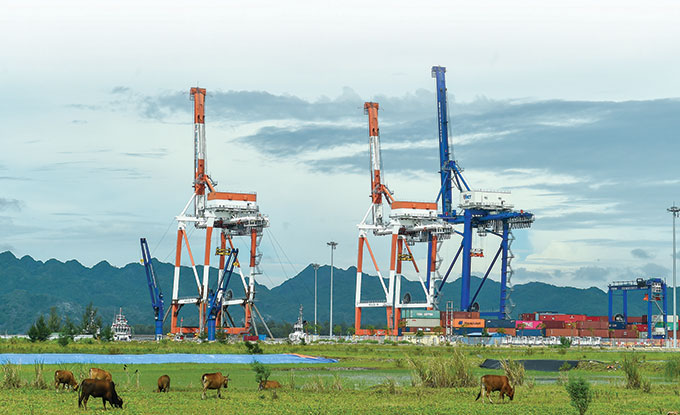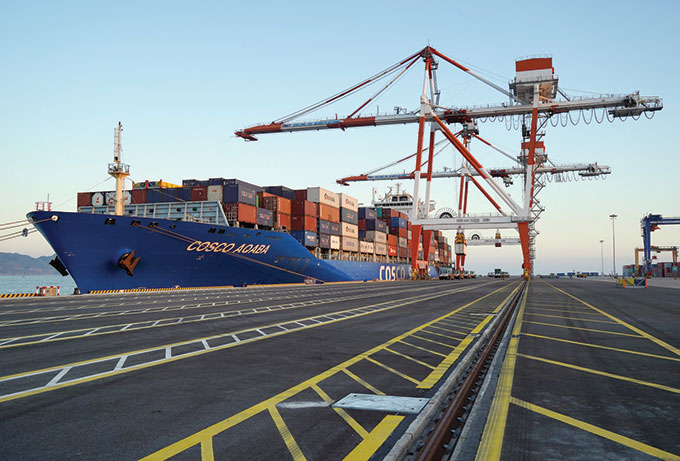
Vietnam’s 3,000 km of coastline and 320 ports increasingly play an important role in global trade. Container traffic rose 3 per cent year-on-year in the first half, while Hong Kong’s fell 8 per cent.
With a high number of supply chains shifting to Vietnam, it makes sense that shipping demand is increasing and Vietnam’s long-term economic trajectory is likely to see this demand continue for years to come.
The government wants the country’s seaports to handle 200 million tons of cargo by 2020 and double that amount by 2030. While this planning becomes reality, investors that need ports for imports or exports need to consider regional variations in the quality of port infrastructure before setting up.
Competitiveness of local ports
Economic growth in Vietnam has led to a significant increase in freight traffic over the last decade, highlighting the importance of ports for companies that invest in the country. While this trend suggests that Vietnam’s ports are able to manage increased demand, it also highlights the need for further investment in infrastructure to keep pace with growth and reduce logistics costs for business.
According to the World Economic Forum, Vietnam ranks 80th among 139 countries and territories on the quality of port infrastructure, with an average score of 3.80 between 2006 and 2018 on a scale of 1 (lowest) to 7 (highest). This puts it lower than countries such as China, India, Thailand, and Sri Lanka.
Vietnam has 44 seaports with a total capacity of 470-500 million tons per year. Major ports include Hai Phong, Da Nang, Quy Nhon, and Ho Chi Minh City. It also has a number of smaller ports, which brings the total to 320.
The Vietnam Port Association (VPA) has said that 80 per cent of container exports and imports go through smaller ports and ships - a process known as transshipment. The VPA also noted that goods owners sustain losses of some $2.4 billion each year due to the lack of deep-water ports.
Here, we highlight major ports in the northern, central, and southern regions of the country that foreign investors can start to look at. As the government continues to expand port infrastructure, we provide an insight into the most developed ports for investors beginning to assess a site location.
Northern Vietnam
Hai Phong and Vung Ang are the major ports for international container traffic in northern Vietnam, but neither are deep-water ports. In May 2018, however, the Haiphong International Container Terminal (HICT) deep-water port opened in Hai Phong. The HICT is capable of accommodating large container ships, reducing the need for transshipments in the country’s north. The port allows for direct shipping between northern Vietnam and the US and the EU. The second phase of the port is expected to be completed by 2020.
Previously, containers heading for Hai Phong or Vung Ang required transshipments, typically using ports in Singapore or Hong Kong, where containers were loaded into smaller container vessels and then transported to northern ports in Vietnam. Avoiding Hong Kong or Singapore means saving about one week in shipments as well as substantial freight transport costs.
The new port is particularly helpful for foreign businesses operating between Hanoi and Hai Phong. It is connected to the Hanoi - Hai Phong Expressway and Tan Vu Lach Huyen Bridge, and its close proximity to China will help companies that use northern Vietnam as a China+1 destination.
Northern Vietnam has become a hub for the electronics, automobiles, and machinery sectors. The Deep C Industrial Zone near the port has already attracted 80 companies, and the port will augment northern Vietnam’s growth further.
Central Vietnam
Major ports in central Vietnam are Quy Nhon and Da Nang Ports, the latter being a deep-water port. The region also has nine minor ports.
Da Nang Port handles the majority of traffic in the central region, which links Vietnam to Myanmar, Thailand, and Laos. Its proximity to the central city of Da Nang is an added advantage, with the city’s infrastructure developing rapidly as it has become a hub for high-tech industries.
Quy Nhon Port is mostly used for transporting goods from the Mekong Delta, along with transshipping goods heading for Cambodia. Port infrastructure in the central region does not currently match the northern and southern regions, but is poised for further development.

Southern Vietnam
The Ho Chi Minh City area consists of a network of ports, with Saigon Port currently the 26th-largest in the world and the fifth-largest in ASEAN, following the Port of Singapore, Malaysia’s Port Klang and Tanjung Pelepas, and Thailand’s Laem Chabang.
Ports in Ho Chi Minh City are the main gateway for the region and account for 67 per cent of total throughput at all Vietnamese ports.
Cai Mep - Thi Via Port (Cai Mep) is a deep-water port located some 80 km south of Ho Chi Minh City. It mostly handles goods for southern Dong Nai and Binh Duong provinces, which are major production centers in the region, and is popular for routes to the US and the EU because of its deep-water capabilities.
Despite being a deep-water port with seven terminals, Cai Mep functions at only 30 per cent capacity due to the large number of smaller ports in the region.
For example, Cat Lai, one of the biggest and most modern container terminals in Vietnam and situated in Ho Chi Minh City’s port area, is preferred over Cai Mep due to its proximity to the city and Binh Duong, Dong Nai, and Ba Ria Vung Tau provinces. It is primarily used on Asian routes, but because it is not a deep-water port there are higher transshipment costs.
Industry challenges
The major challenge facing Vietnam’s largest ports is the use of smaller ports and vessels, which account for approximately 80 per cent of container imports and exports in the country. Some ports also suffer from being over-burdened with shipments, which has led to congestion and significant delays.
For example, Cat Lai is preferred over Cai Mep despite the latter being a deep-water port that can accommodate vessels with a capacity of 18,000 20-foot equivalent units (TEUs). Transshipments through Cat Lai can lead to delays and higher costs of around 30 per cent. The increasing use of Cat Lai has also led to gridlock issues due to delays in weigh stations and road intersections.
Road and rail infrastructure have also not been able to keep up with economic growth. The rail and road network around ports remains underdeveloped, leading to increased costs. Due to the lack of a rail network connecting various ports, freight currently must be transported by road, adding to shipping costs.
Businesses in the country often complain of instances where freight has been held at ports due to customs procedures, resulting in an increased number of containers lying at ports without anyone to claim them. The government will need to streamline customs procedures so that Vietnam does not lose to rivals such as Singapore, Thailand, and Malaysia.
Increasing port capacity
The government not only needs to invest in increasing existing port capacity but also build new deep-water ports to cut transportation costs and increase efficiency, especially in the Mekong Delta. It has introduced a master plan related to the development of seaport systems by 2020 and 2030, which focuses on achieving a cargo clearance target of at least 1 billion tons by 2020 and 1.2 to 1.6 billion tons by 2030. However, the government will need to consider issues such as port placement, connectivity with economic hubs, and proximity to international maritime routes in their planning.
Developing inland waterways
Vietnam has over 42,000 km of inland waterways, mostly in the Mekong and Red River Deltas, which have the potential to increase connectivity and reduce costs for the transportation sector. They suffer, however, from a lack of connectivity to major production centers and inland ports. The development of waterway transport should be a priority for the government to increase market access, connectivity, and efficiency.
Future growth
With large-scale port development in the north and the south, foreign investors from Japan and the Netherlands have expressed interest in developing port projects in the central region around Da Nang. The government is also keen on the development of ports to meet its masterplan for public-private partnerships. Since international trade is conducted mainly via sea-based transport, increasing the number of value-add ports and adding capacity to existing ports will be critical for the government as well as manufacturers to speed up transport and reduce costs. Cargo volume throughput at Vietnam’s ports has increased by 20 to 30 per cent each year.
Ultimately, Vietnam’s ports, if developed efficiently, will help aid the country’s growth over the next decade. Businesses that are keen to manufacture and trade in Vietnam should consider regional differences in port infrastructure and seek to locate in a region that best suits their activities.

















